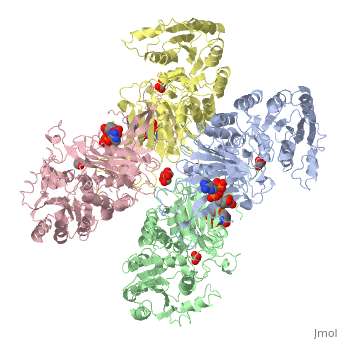Overall, the structure of Glucose-6-Phosphate Dehydrogenase (G6PD) is a tetramer, composed of a dimer of dimers. Glucose-6-Phosphate Dehydrogenase also features a structural nicotinamide adenine, which is only present in eukaryotes and is rare biologically. Glucose-6-Phosphate Dehydrogenase is 515 amino acids long.
Function
Disease
Glucose-6-Phosphate Dehydrogenase deficiency is associated with many diseases, some of which include Hemolytic Anemia and Favism. Hemolytic Anemia results in erythrocytes being destroyed before their typical life span is over. Hemolytic anemia can lead to many problems, including cardiovascular arrhythmia, cardiomegaly (enlarged heart), and fatigue. Hemolytic anemia can present with different severity, but can be treated with drugs.
Favism is a disease associated with G6PD deficiency that can cause oxidative stress as a result of consuming fava beans. Favism and G6PD are X-linked diseases that are thus more prevalent in men than women.
Relevance
Structural highlights
This is a sample scene created with SAT to by Group, and another to make of the protein. You can make your own scenes on SAT starting from scratch or loading and editing one of these sample scenes.

